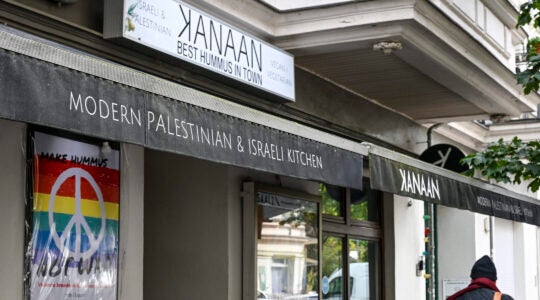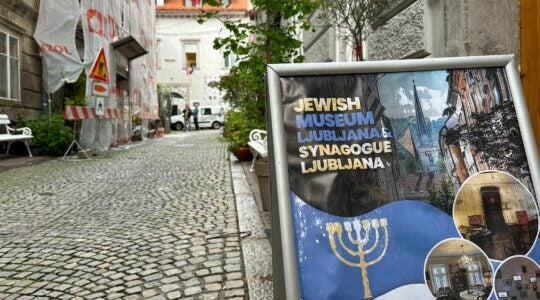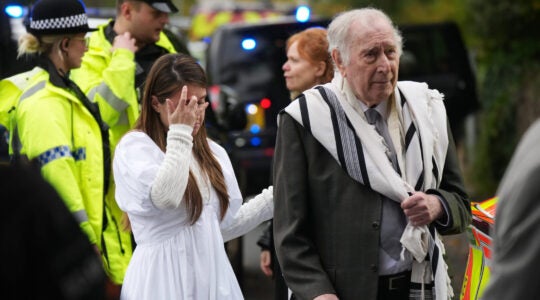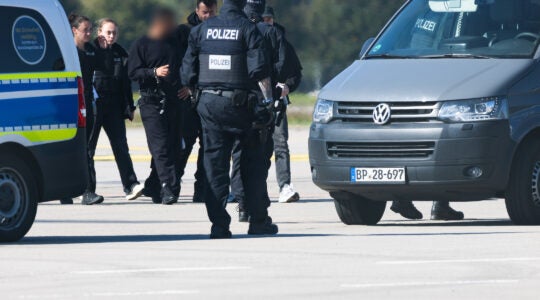
Rabbi Zoltan Radnoti speaking at the ceremony marking the rededication of his synagogue after it was enlarged to three times its previous size due to the growing community. (Ruth Ellen Gruber)
BUDAPEST (JTA) — Linda Ban is a rebbetzin, but with a mass of curly hair and chunky rings on the fingers of both hands, she hardly fits the stereotype of a Central European rabbi’s wife.
A mother of two in her mid-30s, Ban is married to Tamas Vero, the 38-year-old spiritual leader of Budapest’s Frankel Leo Street Synagogue, a neo-Gothic building hidden in a courtyard near the Danube.
The congregation may hold a key to the Jewish future in Hungary.
“My husband and I are building a Jewish community at our synagogue,” Ban says. “But my goal is that our members take Judaism home — into their homes.”
Frankel Leo is among a handful of Budapest synagogues that has seen an upsurge of membership and communal engagement in recent years thanks to active young rabbis and a family-friendly focus.
“A year-and-a-half ago, after I took over as rabbi, our synagogue was almost empty, with just eight or nine people coming on Friday nights,” said Rabbi Istvan Darvas, 38, of the Dozsa Gyorgy Street Synagogue. “Now we have 60 or more each Friday, and we are still growing.”
Another of these congregations, Bet Shalom, had such an increase in membership that it outgrew its premises.
The week before Passover, Bet Shalom, which in the past decade or so has jumped from about 20 members to approximately 250, celebrated the gala inauguration of a rebuilt synagogue complex that includes a new sanctuary that doubles the seating of the previous one to 169.
The event received mainstream media coverage; speakers included the Israeli ambassador.
“It’s the first time in 80 years that a congregation has grown so much that it needed a bigger synagogue,” said Jozsef Horvath, 43, Bet Shalom’s president. “Our old synagogue was too small for the number of people, and there was no place for kiddush and no space for learning.”
With an estimated 80,000 Jews, Budapest has the largest Jewish population of any central European city. It is home to about 20 Jewish congregations, ranging from the dominant Neolog (moderate Conservative) stream to traditional Orthodox and Chabad, to American-style Reform, to informal minyanim such as Dor Hadash, an independent egalitarian congregation that is associated with the Masorti (Conservative) movement.
As in other post-communist countries, there has been a revival of Jewish life and identity since the Iron Curtain came down more than 20 years ago. But the rate of intermarriage remains high — according to surveys about 50 percent — and most of the city’s Jews have nothing to do with organized Jewish life.
Studies show that those who do affiliate often experience Jewishness outside the home and outside the synagogue through organizations that range from the city’s Jewish community center, to youth groups, to the Jewish summer camp at Szarvas in southern Hungary.
Many self-identifying young Jews reject established Judaism and gravitate toward an alternative Jewish youth scene that focuses on cafes and cultural events in the trendy downtown Jewish quarter.
Against this background, the Frankel Leo, Dozsa Gyorgy and Bet Shalom synagogues are, some say, changing the face of Jewish religious life in Hungary.
Led by local rabbis who came of age after the fall of communism, they are attempting to engage young people within the organized mainstream and promote the synagogue as the focus of community, learning and long-term Jewish continuity.
“Real and strong communities can grow around synagogues where families are engaged,” said Mircea Cernov, an educator who attends the Dozsa Gyorgy synagogue. “Probably the children raised in this environment will have an influence in future years.”
Horvath, a civil engineer whose wife is a convert to Judaism, agrees. “This is the future,” he said.
He said he had grown up in an unaffiliated, nonreligious home. It wasn’t until he was about 20 that he learned his mother, a child survivor of the Holocaust, was Jewish. He drew closer to the Jewish world, and to Judaism, when he began to play basketball for the Maccabi sports club in his 20s. He eventually served as the chairman of Maccabi in Hungary for 12 years.
“It was when my first son was born that we decided to start keeping more Jewish rules at home, to light the candles,” Horvath said. “And then, two or three years ago we started coming to Bet Shalom as a family.”
Each of the growing congregations has a different orientation, but all three come under Mazsihisz, the official Jewish umbrella organization. Vero, Darvas and Zoltan Radnoti, the rabbi at Bet Shalom, were all trained at the Neolog Rabbinical Seminary in Budapest.
Radnoti now regards himself as Modern Orthodox, and the new Bet Shalom sanctuary includes a mechitzah, the ritual barrier separating men and women.
He and Darvas both reach out to intermarried families or other non-Jews who wish to convert.
Most of the congregants at Frankel Leo are young couples and families who joined Jewish youth organizations and went to the Szarvas Jewish summer camp as children and teens but had little else to do with organized Jewish life afterward. Now that they are married and have children, said Linda Ban, they are coming back.
“Our congregation is totally based on people we knew at Szarvas or other youth activities, but some of them we haven’t seen for 15 years,” she said. “When they become a family, they want to be Jewish again. But they don’t know how to bring Judaism home, how to have a Jewish home. And I find that sad.”
A rarity in Hungary, Ban and her husband both grew up in traditional Jewish homes. They use their own lives and upbringings as examples in their teaching of Jewish values, traditions and culture to the young families now joining their congregation.
In particular, Ban has incorporated her own family history and experiences in a series of illustrated children’s books that explain and explore Jews, Jewishness and Judaism in simple yet meaningful terms geared toward everyone in any extended modern family.
“Countless parents have difficulty talking to children about Judaism because they are full of unanswered questions themselves,” she wrote in “What Does It Mean to Be Jewish,” one of her books that also was published in an English-language edition.
“I would like to create opportunities,” she wrote, “for all members of the family — grandparents, parents, step-parents and children, Jews and non-Jews, believers and non-believers alike — to talk to each other openly and honestly about Judaism, without taboos, expectations or prescribed answers.”
JTA has documented Jewish history in real-time for over a century. Keep our journalism strong by joining us in supporting independent, award-winning reporting.





